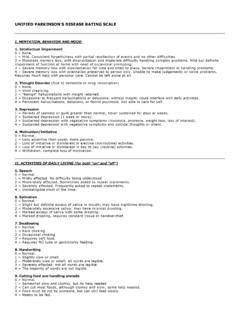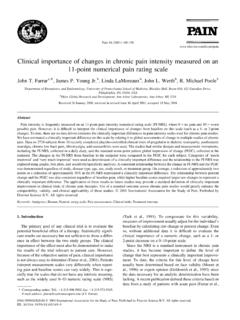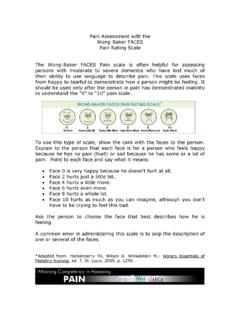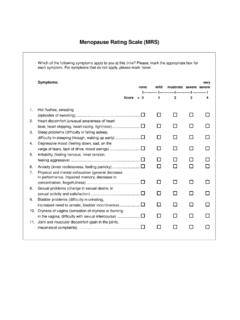Transcription of A well-established measure: The Unified Parkinson’s ...
1 8130_Teva 6/5/06 9:19 AM Page 1. A well-established measure: The Unified Parkinson's Disease Rating scale (UPDRS). Developed to address the need for a comprehensive PD measurement tool1,2. Introduced in 1987 by a team of PD investigators as an overall assessment scale that would quantify the signs and symptoms of PD. Allows for both an overall measure of disability and individual subscores Encompasses earlier rating scales: Hoehn and Yahr staging scale (assessed motor skills), and the modified Schwab and England activities of daily living (ADL) scale 20 years of broad usage: UPDRS is the most commonly used research tool to evaluate new treatments for Parkinson's disease Designed to assess PD symptoms Includes both scoring by a clinician (motor examination) and a historical report of mental functioning and activities of daily living (ADL) obtained by questioning the patient Allows the clinician to assess the worsening or improvement of PD over time Symptomatic worsening/improvement can be measured as a change from baseline Worsening of symptoms increases score Improvement in symptoms decreases score Example of a UPDRS chart measuring the change from baseline (mean SE).
2 3. Worsened 2 increased score indicates worsening of 1 PD symptom(s). 0. decreased score -1 indicates Group A. improvement in PD symptom(s). Improved -2 Group B. -3. The UPDRS is a useful way to maintain The most widely used standardized an ongoing record of patient function scale to assess parkinsonism is the and to assess disability. 1 UPDRS. 3. (Olanow, 2001) (Rascol, 2002). 8130_Teva 6/5/06 9:19 AM Page 2. Overview of UPDRS and subscale items Total UPDRS consists of four parts2. Parts I, II, and III contain 44 questions each measured on a 5-point scale (0-4). I. Mentation, behavior, and mood: intellectual impairment, thought disorder, motivation/initiative, depression II. Activities of daily living (ADL): speech, salivation, swallowing, handwriting, cutting food, dressing, hygiene, turning in bed, falling, freezing, walking, tremor, sensory complaints III. Motor examination: speech, facial expression, tremor at rest, action tremor, rigidity, finger taps, hand movements, hand pronation and supination, leg agility, arising from chair, posture, gait, postural stability, body bradykinesia In monotherapy, a Total UPDRS score is the combined sum of parts I, II, and III: 0 (not affected) to 176 (most severely affected).
3 In adjunct therapy, part IV is included. Part IV contains 11 questions and the scale can range from 0 to 23. IV. Complications of therapy: dyskinesia-duration, dyskinesia-disability, dyskinesia-pain, early morning dystonia, offs -predictable, offs -unpredictable, offs -sudden, offs -duration, anorexia-nausea-vomiting, sleep disturbance, symptomatic orthostasis Motor subscales provide a measure of key motor symptoms Representative sample of key measurement items from the UPDRS scale2. UPDRS Item Assessment scale Measurement Range Score includes body bradykinesia and hypokinesia 0 (not affected). Bradykinesia subscale to 36 (most severely affected). left- and right-hand finger taps, opening and closing of hands, pronation/supination of hands, and heel taps Score includes action tremor of right and left hands 0 (not affected) to Tremor subscale resting tremor in the left and right hands and feet 32 (most severely affected).
4 Resting tremor of the face, lips, and chin Score includes 0 (not affected) to Rigidity subscale rigidity in the neck 20 (most severely affected). rigidity in the left and right upper and lower extremities PIGD (postural Score includes 0 (not affected) to instability and gait falling, freezing, ability to walk 20 (most severely affected). disorder) gait, postural stability References 1. Olanow CW, Watts RL, Koller WC. An algorithm (decision tree) for the management of Parkinson's disease (2001): treatment guidelines. Neurology. 2001;56(11 suppl 5):S1-S88. 2. Fahn S, Elton RL, UPDRS Development Committee. Unified Parkinson's Disease Rating scale . In: Fahn S, Marsden CD, Calne DB, Goldstein M, eds. Recent Developments in Parkinson's Disease. Florham Park, NJ: Macmillan; 1987:153-163. 3. Rascol O, Goetz C, Koller W, Poewe W, Sampaio C. Treatment interventions for Parkinson's disease: an evidence based assessment.
5 Lancet. 2002;359:1589-1598. 2006 Teva Neuroscience, Inc. 05282201/050727.






